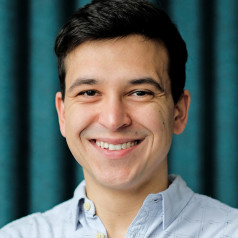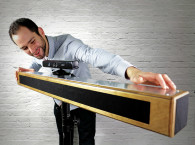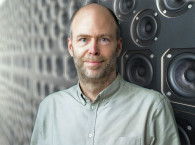
Headquartered in Tempelhof, Berlin, Holoplot is a company on a mission to transform the audio industry. In 2021, it launched the X1 Matrix Array — a product that has introduced a whole new category of sound system. The Matrix Array is the logical continuation of two already existing landmark innovations in pro audio — the line array and electronic beamsteering — and provides control of sound in both horizontal and vertical axes through a matrix of loudspeaker drivers.
Conventional high-performance line arrays are by now a commodity in our industry, but high-performance has been hard to achieve for beamforming loudspeakers historically. The prevailing preconception in the industry is that beamforming loudspeakers cannot perform well in full-range applications — or that they are very costly, and very complex to design and manufacture. With X1, Holoplot and our team set out to prove these assertions wrong.
The X1 product series features two audio modules. The Modul 96 (MD96) is a two-way audio module integrating 96 drivers in a two-layered matrix design. The Modul 80-S (MD80-S) is a three-way audio module with 80 drivers in its first two matrix layers and a sensor-controlled subwoofer driver in its third layer. This matrix arrangement of loudspeaker drivers of different size s— in a unique multi-layered configuration — enables control over sound propagation across a large frequency range, while providing the SPL and quality desired for high-performance sound reproduction.
With this configuration, X1 offers a wide range of previously inaccessible sound control capabilities. Each module can create up to 12 individual and independent beams, able to reproduce differing content at the same time. With just one centralized Matrix Array, sound propagation can be tailored to cover an audience area and precisely target one or multiple zones.
The X1 concept did not emerge fully formed in some kind of “Birth of Athena” moment. Quite the contrary, the concept and creation of X1 is the result of tireless work of multiple specialists drawn together from across the music and computer technology, consumer electronics and pro audio space.

The Holophonic Approach
Beginning its journey back in 2011, up until 2016 Holoplot was primarily a research company run by Tonmeister Helmut Oellers, and DSP engineer Adrián Lara Moreno. The original vision for a loudspeaker in Matrix Array format came from Helmut — with his earliest ideas still published and publicly accessible at www.syntheticwave.de. Helmut has a long history of trying to understand existing audio reproduction methods and the drawbacks they present, such as the limitations of phantom sources or the acoustic overlap between the room acoustics present in a recording and room acoustics of the space where the recording is being reproduced. To overcome the limitation of those methods, Helmut came up with what he named “holophony.” His holophonic approach involves the use of Wave Field Synthesis and two-dimensional speaker arrays, which was the foundation for his first patent back in 2004. Out of this patent, Holoplot was born to turn that theoretical vision into reality.
Researching the Matrix Array concepts was the main objective of Helmut and Adrián during the initial years. The arrival of Roman Sick as Holoplot CEO in 2016 enabled them to turn concepts and prototypes into a commercially viable product that could address the needs of the pro audio market.
“I met the Holoplot team when they were just four people working from a garage outside of Berlin, but I very quickly realized the game-changing potential of what they were trying to do. When the opportunity presented itself to lead the company I decided to commit and signed on with the original engineers on board. Growing the team, setting up our headquarters in Berlin, and commercializing the product was an intense but extremely exciting time. I was intrigued by the potential, as well as by the challenge of developing a radically new technology, which I’m convinced will change the world,” recalls Roman Sick.
“X1 is a powerful toolset, which offers a wide range of benefits for a variety of use cases across multipurpose arenas, concert halls, immersive venues, conferences, places of worship, and more. The unprecedented control over sound X1 can achieve allows us to minimize the impact of the architecture and acoustics of the room, and the system just sounds phenomenal,” he adds.
X1 was preceded by Holoplot’s original Orion system. Orion wasn’t designed to be a fully-fledged solution for a multitude of applications, but rather as a product that could demonstrate the fundamental ideas of the combination of 3D Audio Beamforming and Wave Field Synthesis (WFS). It was designed for niche applications that aren’t serviceable with “standard” audio technology and consisted of the Io Audio Module and Eta Core processor. Utilizing the knowledge gained from more than six years of research, the Orion system was capable of generating multiple highly efficient audio wave fronts, ranging from spherical to cylindrical and planar, and could control them precisely in the vertical and horizontal axis.

As Adrián Lara Moreno, Head of Research at Holoplot explains, “Orion is the genesis of X1, but already then was the culmination of many years of research turned into a product designed for specific use cases in the pro audio space. When we transitioned from Orion to X1, we kept the knowledge and experience from the past, and added new perspectives and invaluable input from notable industry experts to continue the journey.”
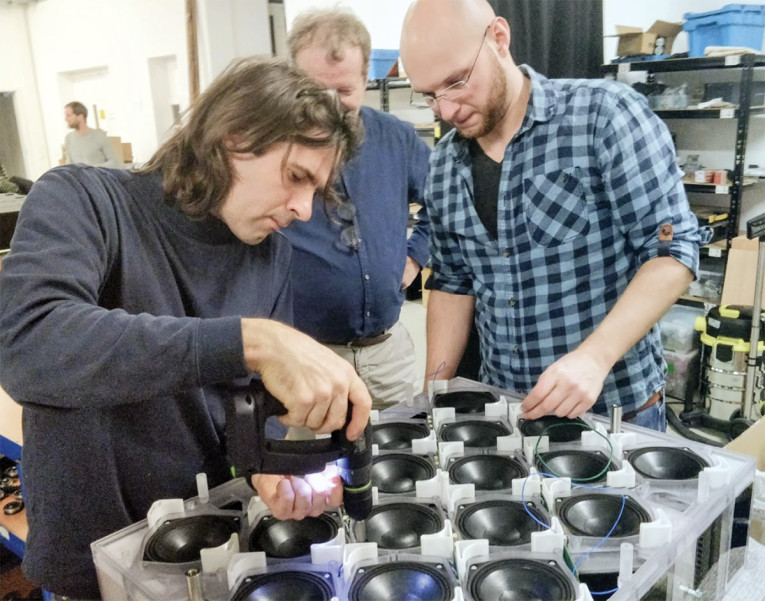
“The design criteria for Orion were very loose originally, but Helmut and I were in agreement it had to be a scalable, two-dimensional system. Essentially Orion combined loudspeaker array technology and electronic beamsteering in a way that no one else had attempted before. Holoplot’s approach to Wave Field Synthesis was different from the traditional approach — most had combined signal processing with traditional point source loudspeakers, and required the installation of those loudspeakers all around the listener to create an immersive effect. Holoplot’s proprietary loudspeaker and processing technology allowed us to handle the wave propagation in a completely new and more finely controlled way. We were for example able to create virtual sound sources through room reflections — meaning it was for the first time possible to expand traditional WFS and create a fully immersive audio experience utilizing just a single Matrix Array.”
With the Orion system Holoplot completed a variety of significant tests and projects. The company successfully deployed a centralized WFS immersive soundscape of the Vienna Philharmonic Orchestra and created sound reinforcement systems with minimum SPL loss across many hundreds of meters.
Orion was also deployed to deliver immersive audio content for Nintendo at the 2019 Electronic Entertainment Expo in Los Angeles, CA. The well-known gaming company called upon Holoplot to deliver targeted sound effects utilizing Holoplot’s multiple content zoning capabilities for a trade show gaming installation marking the launch of their action-adventure game Luigi’s Mansion 3.
Another highlight for Orion was scoring some of the highest Speech Transmission Index (STI) measurements ever recorded on a train station platform. They were so incredibly high, that the acoustic consultant wondered whether his measuring device was malfunctioning and re-ran the test — with the same unbelievable results of 0.61 STI over a 180m distance. For reference, an STI value of 0.5 would have already represented an enormous improvement for the station compared to the performance of its installed system.
“Orion gave us the chance to develop, experience, and iterate Wave Field Synthesis and 3D Audio Beamforming. We see the combination of these technologies as a logical consequence of previous industry advancements: a natural evolution of existing technology — but a revolution in its potential applications, on par with the introduction of the Line Array to the pro audio world in the 1990s,” Moreno adds.
The X1 Project
Holoplot as a company emerged from the desire to radically change the way we can manipulate and utilize sound. It acted upon the realization of major shortcomings in the pro audio industry — not much had changed in the way sound systems were deployed since the introduction of the line array, and the Holoplot team was determined to create a new, unsurpassed loudspeaker solution that would start a new chapter on what’s possible in sound reproduction and control.
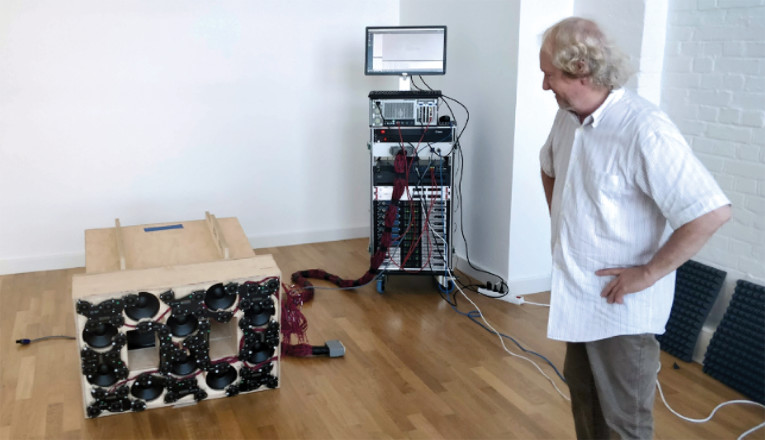
The creation of X1 was accelerated by the need to create something custom and never done before, to cater to the specific requirements of one of the most ambitious AV venue projects in this decade, set to redefine audience experience standards inside the live entertainment industry. This was the catalyst for Holoplot to evolve its technology by an order of magnitude to truly deliver on concert-level performance requirements.
Essentially, Holoplot came to the realization that a new product had to be developed, and needed to be bigger and much louder. To achieve this, the company extended its engineering team with Michael Hlatky as the Development Lead on the engineering side, Philippe Robineau as Acoustic Lead, and Evert Start as DSP Lead.
As Michael Hlatky, now Head of Engineering at Holoplot details, “Philippe `Bob’ Robineau approached us in 2018 and very modestly suggested he might know a thing or two about designing loudspeakers, and that he thought he could be of help. Having started his career as the Chief Engineer at Nexo, to later leading R&D at Turbosound, Focal, Tannoy, and Adam Audio, we couldn’t have wished for anyone better on the electro-acoustic design of X1. Philippe was instrumental in the creation of the multi-layered Matrix Array configuration, enabling control over sound propagation across a large frequency range, while providing the SPL and quality desired for high performance sound reproduction. X1 is the culmination of Philippe’s experience in designing loudspeakers for the pro audio industry, spanning a career of more than 50-years.”
“Philippe suggested extending the team with Evert Start, who himself brought invaluable years of pro audio experience when he joined Holoplot in 2019. He’d been working on Wave Field Synthesis since university and later, as a research engineer at Duran Audio (acquired by Harman). He introduced the world’s first beam-shaping algorithm for the Intellivox loudspeaker arrays, which marked the starting point of the successful adoption of beamsteering column loudspeakers inside the pro audio industry.”

Creating X1 certainly hasn’t been a simple process, or a natural one. The issues Holoplot faced in bringing this technology to life have been many. For example, X1 uses an unheard of number of drivers, each one individually driven and signal processed via 8700 digitally controlled filters computed in real time.
The amount of amplifier channels required to achieve this inevitably leads to a huge amount of heat to manage, and a seemingly insurmountable amount of DSP needs to be computed in real-time. To put this into perspective, a relatively small 3×3 X1 Matrix Array usually has more amplifier channels than the largest installation of conventional loudspeaker systems.
Michael Hlatky details how the project evolved: “I joined Holoplot in May 2018 to manage the X1 development. At that point the general concept of a three-layered Matrix Array already existed, and, based on that, an off-the-shelf driver and amplifier selection for a very first acoustic prototype had been made.

“Our initial development team was small, consisting only of one electrical engineer, one mechanical engineer, two software developers, and one DSP developer. Our mission was to build an acoustic prototype of X1 in the space of only four months so we could validate the viability of a design proposal for a certain mega project we were approached by. We delivered on their brief thanks to X1’s unique and unparalleled audio capabilities and are immensely proud to have been chosen as the exclusive audio supplier for the project.

“After presenting that very first acoustic prototype we gained the confidence of the project’s executive and continued the development of X1, to build the highest performance concert-grade loudspeaker ever created.
“One of the main challenges in designing X1 was taking very high-level project requirements and breaking them down into a product design and system concept that not only sounds and works great, but is also mass manufacturable within a certain cost envelope. Achieving that within the timeframe set by the project’s construction timeline meant we were limited in certain aspects of what we could do, which was insanely challenging. To be able to do this, we grew the development team from initially five people to more than 40 in just a year’s time, a mammoth challenge.”
Apart from creating an entirely new category of sound system, rapidly growing a capable team of experts to execute the goal represents another great achievement for Holoplot, and shows how impactful and convincing its mission and technical concept was from very early on.
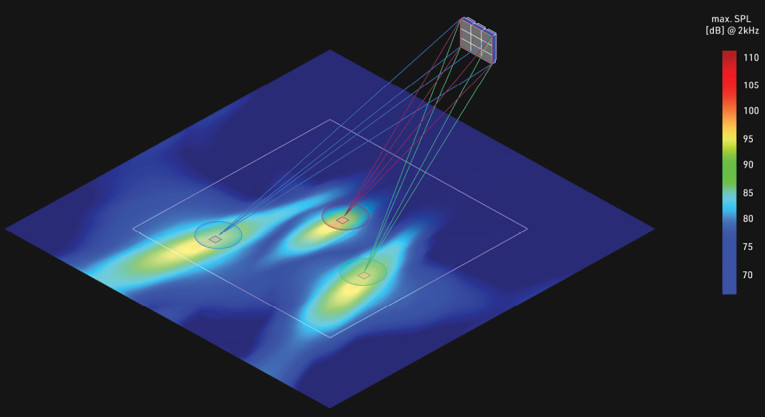
Taking It Further
With the development of X1, Holoplot broke the misconception that directed sound products could not be “loud.” Holoplot can go big, go loud, while providing uncanny control over sound propagation, and still offer exceptional sound quality.
The main principle of any array technology is wave interference. Sound waves emitted by multiple sources interact with each other. Constructive interference occurs when the individual sound waves reinforce each other — building a wave of greater amplitude. Destructive interference occurs when the waves oppose each other. For waves that are neither fully in-phase nor out-of-phase, partial reinforcement or cancellation occurs.
“By combining multiple loudspeaker drivers into an array, sound can be reinforced in a specific direction, while being attenuated in other directions. Similar to frequency filters boosting or attenuating certain parts of a signal spectrally, beamforming allows us to ‘filter’ sound spatially. The conventional way of directing sound is by mechanically aiming and curving the loudspeaker array. Obviously, this doesn’t provide much flexibility. If the sound coverage of the audience needs to be changed, the mechanical array configuration needs to be modified,” details Evert Start, Fellow Research Engineer at Holoplot.

In addition to this, in many venues the architectural integration of curved and tilted arrays is quite challenging. Using 3D Audio Beamforming, these problems can be overcome. “By processing the signal to each driver individually, the radiation pattern of an array can be ‘molded’ into any desired shape, providing more flexibility regarding system integration — which has clear advantages for both indoor and outdoor applications.”
“The biggest challenges we face when developing a beamsteered product are the array size and driver spacing. At low frequencies we need a large array to obtain sufficient directivity control. At high frequencies a small array will do, but a very dense driver distribution is required in order to avoid spatial aliasing. Meeting all of these physical requirements is practically very challenging,” Evert Start adds.
“In the past, several attempts have been made to fulfill these criteria. Depending on the chosen approach, either a mechanically curved line array was used consisting of sparsely spaced, highly directional wave guides, or a column loudspeaker consisting of densely spaced, wide angle drivers. The former approach is quite inflexible due to the mechanically set array curvature and doesn’t provide the option of multiple beams aimed in different directions, possibly playing different audio content. The latter can provide this flexibility but is limited with respect to the maximum SPL due to low array efficiency at high frequencies.”
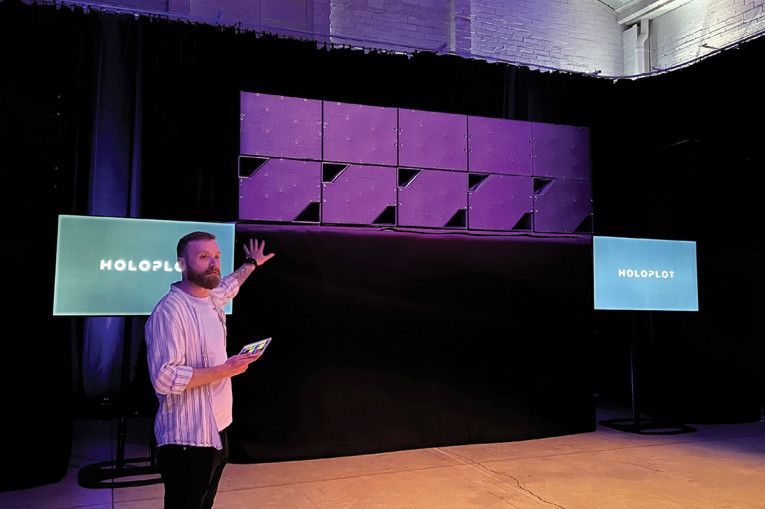
“Building on from the principles of Wave Field Synthesis and optimized Beamforming, a new and unique technology arose, which can be best described as “Inverse Wavefront Shaping.” Applying very efficient, ultra-high-channel, numerical array optimization, any sound field or beam can be created, originating from a virtual point, line or optimally curved, planar source. This ensures optimum coverage, high array efficiency, and spectral consistency across large audience areas of any shape and size, or, conversely, allows tight focusing of audio content onto small groups of people, even down to individual audience members. In this way, a single Matrix Array can generate multiple sound fields simultaneously, each with its own content.”
X1 is software-driven hardware. Both elements are intrinsically linked and interdependent. The hardware requirements are high and Holoplot believes that only few others in the industry are producing products with similar standards in performance and quality.

It could probably be argued that Holoplot’s software is the major innovation driver now, and our efforts are currently focused on creating better sound through better signal processing algorithms, and better workflows. To that end, we are constantly expanding our software engineering team under Head of Software Engineering Bram de Jong, with a focus on world-class talent in signal processing, distributed systems, and modern C++.
High-performance entertainment is where Holoplot operates right now, and the best examples of that can currently be experienced at the Dark Matter light and sound exhibition in Berlin, or at Illuminarium Atlanta and Las Vegas — immersive entertainment experiences that guide visitors via a multi-sensory journey through the heart of an African Safari, space exploration or deep dive into seemingly out of this world kinetic sound and light sculptures.

Holoplot is now world leading in terms of spatial and immersive capabilities, such as enabling true lifelike reproduction of content via virtual sources and three dimensional placement of audio objects, but its technology is certainly not limited to the “immersive” space.
X1’s 3D Audio Beamforming and zoning capabilities not only make it a creative enabler but also a high quality audio product, able to solve complex acoustic problems.
The X1 Matrix Array can create precise sound fields or zones that contain the sound where it is needed without exciting the room unnecessarily. The result is clear, uncompromised audio for speech, music or other content that renders the audio system acoustically invisible.
Holoplot wants all sectors of the sound world to benefit from the technological leaps it made and is working on a harmonized, integrated, and seamless workflow for system designers, content creators, and integrators that will make it easier to pick Holoplot as their preferred choice for a wide range of use cases. To that end, X1 is just the start.
The software toolkit, together with the X1 rigging system, which Holoplot just demonstrated for the first time at InfoComm 2022 in Las Vegas, NV, will serve as accelerators for the company’s go-to-market, further empowering users to realize their creative visions — on any given scale, large or small.
This article was originally published in audioXpress, September 2022.
 About the Author
About the AuthorMichael Kastner is the Head of Product at Holoplot. Since joining in 2019, Michael has been instrumental in bringing the X1 Matrix Array to life and into the market. Before this, he held product roles at Bragi, the creator of the world’s first truly wireless and smart headphones. He later led the commercialization and development of Bragi’s next-generation hearable platform, laying the groundwork for its software-driven B2B business.


